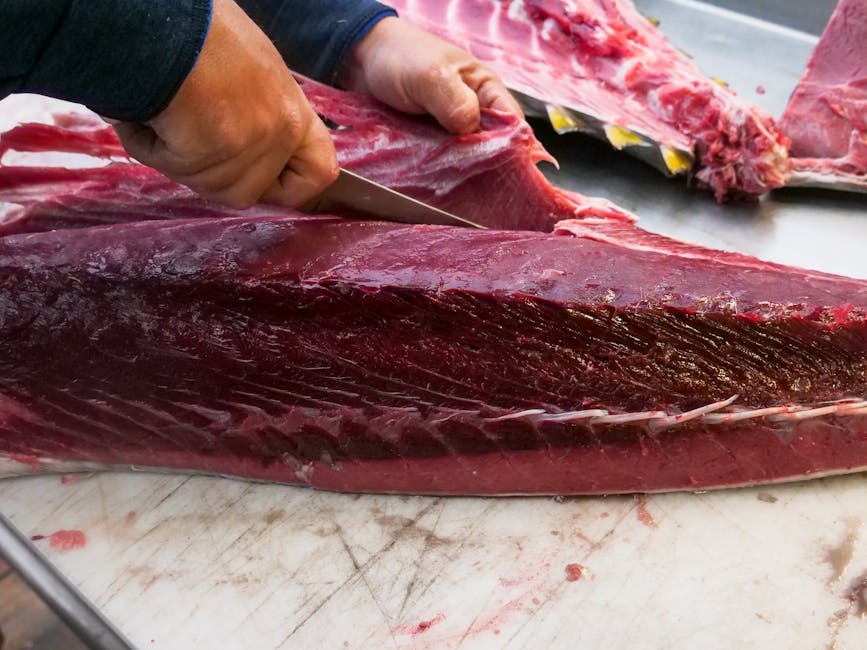Understanding Different Cuts of Fish
When it comes to preparing a delicious seafood dish, understanding the different cuts of fish can make a world of difference. From fillets to steaks, each cut offers a unique texture and flavor profile that can elevate your cooking to new heights. In this comprehensive guide, we will delve into the various cuts of fish, exploring their characteristics, best uses, and how to properly cook them. So, grab your chef’s knife and let’s dive into the world of fish cuts!
The Importance of Knowing Fish Cuts

Before we start dissecting the different cuts of fish, it’s essential to understand why knowing about them is crucial. Just like with any other protein, the way you cut fish can impact its taste, texture, and cooking method. By being familiar with the various cuts, you can choose the best option for your recipe, ensuring a flavorful and well-prepared dish.
Fillet

One of the most popular cuts of fish is the fillet. A fillet is a boneless piece of fish that has been removed from the spine. Fillets are versatile and easy to cook, making them a favorite among home cooks and professional chefs alike. They are perfect for pan-searing, grilling, baking, or even raw preparations like sushi.
When selecting a fillet, look for one that is firm, with a shiny surface and no discoloration. It’s essential to handle fillets gently to prevent them from falling apart. To cook a fillet, you can season it with your favorite herbs and spices, then cook it in a hot skillet with a bit of oil until it’s golden brown on the outside and flaky on the inside.
Steak

Another popular cut of fish is the steak. Fish steaks are cross-section slices of the fish that contain the bone. Steaks are thicker and meatier than fillets, making them ideal for grilling or broiling. Common types of fish steaks include tuna, swordfish, and halibut.
When choosing fish steaks, look for ones with a bright color and a firm texture. To cook a fish steak, you can marinate it in your favorite sauce, then grill it over high heat for a few minutes on each side. The bone in the steak helps retain moisture and flavor, resulting in a juicy and delicious dish.
Whole Fish

Cooking a whole fish can be intimidating for some, but it’s a rewarding experience that allows you to enjoy the full flavor of the fish. Whole fish can be roasted, steamed, or fried, and they are often served with the head and tail intact for presentation purposes.
When buying a whole fish, look for clear eyes, shiny scales, and firm flesh. You can ask your fishmonger to clean and scale the fish for you if you prefer. To cook a whole fish, you can stuff it with herbs and citrus, then roast it in the oven until the flesh is flaky and tender.
Cheeks
While not as common as fillets or steaks, fish cheeks are a delicacy that shouldn’t be overlooked. Fish cheeks are tender, flavorful morsels located on either side of the fish’s head. They are prized for their rich taste and silky texture, making them a popular choice among seafood enthusiasts.
To cook fish cheeks, you can lightly season them with salt and pepper, then sear them in a hot pan with butter until they are golden brown on the outside and tender on the inside. Fish cheeks are perfect for appetizers or as a gourmet addition to your main course.
Caviar
While not a traditional cut of fish, caviar is a prized delicacy made from the roe of sturgeon fish. Caviar comes in various colors and sizes, with each type offering a unique flavor profile. It is often enjoyed as a luxury appetizer or as a garnish for dishes like sushi and oysters.
When buying caviar, look for glossy beads with a fresh aroma. Caviar should be served chilled in a non-metallic container to preserve its delicate flavor. Enjoy caviar on its own or paired with blinis, crme frache, or chopped onions for a luxurious culinary experience.
Common Misconceptions
One common misconception about fish cuts is that they are all interchangeable. While you can substitute one cut for another in some recipes, each cut has its unique characteristics that can affect the final dish. For example, a fillet will cook faster than a steak due to its thinner profile, so you may need to adjust the cooking time accordingly.
Another misconception is that fish cuts are only suitable for specific cooking methods. While fillets are often pan-seared or baked, they can also be grilled or broiled with delicious results. Similarly, steaks can be roasted or fried in addition to grilling, offering a variety of cooking options for different cuts.
FAQs
Q: Can I substitute fish cuts in a recipe?
A: While you can substitute one cut for another in some recipes, it’s essential to consider the differences in texture and cooking time. For example, a fillet will cook faster than a steak, so you may need to adjust the cooking time accordingly.
Q: How do I know if a fish cut is fresh?
A: Fresh fish should have clear eyes, shiny scales, and firm flesh. It should not have a fishy odor or be slimy to the touch. If in doubt, ask your fishmonger for advice on selecting the freshest cuts.
To Wrap Things Up
Understanding the different cuts of fish is essential for creating delicious and well-prepared seafood dishes. Whether you prefer fillets, steaks, or whole fish, each cut offers a unique flavor and texture that can elevate your cooking to new heights. By knowing how to select, cook, and enjoy each cut, you can expand your culinary skills and impress your family and friends with gourmet seafood creations. So, the next time you’re at the fish market, don’t be afraid to try a new cut and experiment with different cooking techniques. Your taste buds will thank you!




